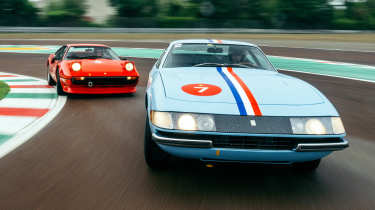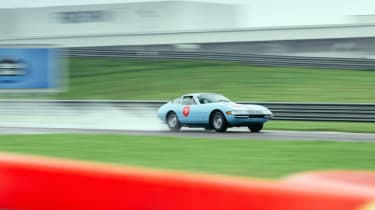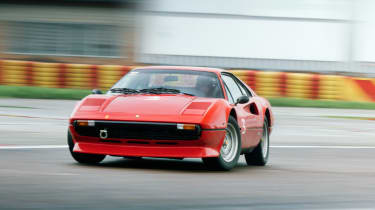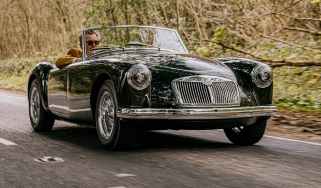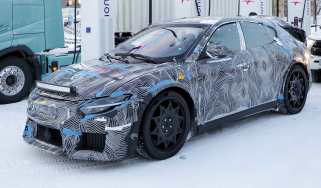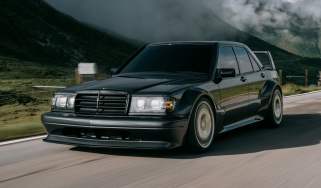Ferrari 365 GTB/4 Daytona v 308 GTB at Fiorano – the joys of driving a classic, manual Ferrari
Ferrari’s finest road-going machines of half a century ago are a world away from today’s tech-laden 12Cilindri. But exactly how difficult are they to master?
The world beyond may have changed, but within the barriers of Fiorano, inside this gorgeous powder blue Ferrari Daytona, it’s 1972. Of course it is; the car is immaculate, its wood-rimmed Nardi wheel box fresh in my hands, the suede dashboard crisp and bobble-free. The circuit traces the same path as when it opened 51 years ago too, and as I squeeze the throttle out of Fiorano’s hairpin, I’m reminded that these were the days before e-diffs and traction control. The big Daytona lurches into a few degrees of slip and I open the steering wheel to keep its long nose pointing vaguely where I’d like to go next. Did I mention it was raining?
I’ve never driven a Ferrari before, and editor-in-chief Stuart Gallagher is acutely aware of this. So when he forwarded an invite from Ferrari to drive a 308 GTB and a 365 GTB/4 Daytona around the fabled test track, he knew I’d snap it up. Plans were cancelled, the diary was cleared – I had to be there. I’ll be taking part in the Corso Pilota Classiche programme, a course designed to teach Ferrari owners who have little or no experience of the marque’s back catalogue the intricacies of driving an old-school supercar to the limit within the safe confines of a track. It’s one of Ferrari’s many customer driving events that encompass everything from vintage Formula 1 cars to track-only XX models, and with each car on this event prepared by the company’s in house Classiche restoration department, it’s a chance to step back in time to sample them in their truest, most original form.
With unassisted steering and no coddling electronics, classic supercars really do pay you back for the effort and skill you put into driving them. In the current age of highly digitised Ferraris, this physicality and mechanical connection is very hard to come by. So too, of course, is a manual gearbox; the last Ferrari available with three pedals was the California of 2008, and just two – yes, two – were made (although my colleagues tell me that car had bigger things to worry about than its gearbox). Today there simply isn’t a strong enough business case to cater for such a small pool of customers, but as I’m about to find out, the romance of driving a Ferrari with an open-gate manual is hard to deny. On route to the airport I rehearsed my rev-matching technique in my diesel SEAT Cordoba; I really didn’t want to fumble a gearshift in an old, fragile Ferrari that costs as much as a house. Or two.
It’s raining hard – really hard – when photographer Aston Parrott and I arrive at Fiorano, so much so that the furrowed brows of the officials suggest that our track time, and my first drive of a Ferrari, is hanging in the balance. We loiter as an Alfa Giulia pace car heads out for some sighting laps to assess the track conditions, which are borderline but just about driveable, and we’re mercifully given the green light. There’s a fleet of 308s warming up in the pitlane with pockets of steam fizzling out of their engine lids, but my eyes are drawn to the majestic, TDF-liveried Daytona parked near the entrance to the track. As the other attendees chat amongst themselves and don their helmets, I make a beeline for it.
Clambering into the Daytona’s tiny fixed-back bucket seat, I almost wish the whole thing had been rained off. There’s no way I can drive this car with any level of competence. With my helmet squeezed against the headlining I’m looking through the windscreen at an angle, my knees are splayed out either side of that enormous Nardi steering wheel, and the wheel itself is canted away so I can barely reach the top of it. It’s truly the worst driving position I’ve encountered in any car, and I’ve driven a Citroën Ami. It feels so evocative though, and before I can get comfortable the marshals give me the hurry up to get going. The quad-cam 4.4-litre Colombo V12, force-fed by a bank of six Weber carbs, chunters into life after a few turns of the crank. The rev needle flickers below 1000rpm on the Veglia clock face, settling as I click-clack into first, add some throttle and release the clutch. Everything feels heavy, and as I exit the pits, I’m engaging my entire upper body to steer out onto the track. It’s not quite the elegant departure I imagined.
The Daytona was intended for use on the road, mostly at high speed, and usually in a straight line. In other words, it was not designed for Fiorano’s first corner: a devilishly tight right-hand hairpin that immediately swings left at the exit. I turn in and the car feels enormous, and for a moment my heart stops as I realise I need to throw much, much more steering lock at it to get round. Old cars, you see. It’s a sequence that the new 12Cilindri would dispatch with a flick of the wrists, but the Daytona’s making me work for it. I tickle the throttle as soon as the corner opens up and the weight squashes down on the rear Pirellis; traction feels decent, so as the engine response cleans up above 3000rpm, I bury it. Oh my goodness. The Webers suck in gobfuls of air and the noise is sublime; warm and rich but with an underlying mechanical intensity that fills the cabin and builds to the red line at just over 7500rpm. With 347bhp it pulls forcefully too, but the delivery is linear and velvety smooth. What an engine. This is what Enzo meant by getting the rest of the car for free...
The track (and the kerbs in particular) is still very slippery, so in the faster sections I’m a touch cautious. The Daytona piles on speed effortlessly and feels hot hatch quick, but this is no foolproof Golf R. With slow, heavy steering, no driver aids and a fair chunk of mass behind (around 1500kg), it’ll take a mighty effort to gather up a big slide. So I ease it around the track with smooth but deliberate inputs, soaking up messages through the seat and that comically large wheel. There’s an industrial-grade heft to the gearshift as you manoeuvre around the open gate but it feels wonderfully mechanical, and you get a clear sense of how hard you’re working each contact patch as the car rolls onto its outside tyres and squirms out of corners. When I first squeezed myself inside I thought the Daytona might quite literally be a pain in the neck to drive, and while it requires considerably more thought, patience and respect than something modern, it’s utterly captivating if you drive at its natural pace.
Parked next to the Daytona, the 308 isn’t upstaged as you might expect it to be. It doesn’t have the same almost mythical presence, but it looks leaner and lighter, as if all the excess bloat has been carved away to leave what is a stunning, crisp Pininfarina wedge. I just about fit inside, too, which is a start. After the Daytona it feels like I’m sitting at the nose, right in the heart of the action, which gives me confidence to push straight away. Admittedly, the fact the 308 is about a tenth of the value also plays a part in that.
With a snorting 2.9-litre V8 mounted behind me rather than in front, the character change is stark and I’m having to relearn all the techniques I practised in the Daytona. There’s a flightiness to the 308 that demands a more delicate touch, and the balance seems to shift dramatically from corner to corner. At low speed the front tyres judder across the road as you power away from the apex, but through Fiorano’s fast, sweeping chicane it’s the rear that feels nervous; you need a brief pause between the direction change to settle the car and avoid a big sideways snap. It’s really making me think, and because it’s lighter and more reactive than the Daytona, your focus and commitment ratchet up a notch or two. There are still quirks to drive around – the steering in particular feels vague until it’s loaded up in the meat of a corner – but there’s just enough precision to exploit that natural mid-engined balance, and I get more comfortable as the laps tick by.
This 308 feels a little thin at full noise, particularly after the glorious, big-chested delivery of the Daytona, but the 251bhp V8 revs freely with crisp response in the upper reaches. It takes a few laps to tune into just how much throttle is needed for each downshift blip under braking, but the rewards are worth it – that oh-so-sweet feeling as you release the clutch and the revs barely change, the car staying absolutely stable, the V8 wailing and primed for when you get back on the throttle. The gearshift is slightly lighter this time but you still need to put your shoulder into each change, hearing the synchros spin up as you coax the lever into the next slot.
In both cars, these sensations tickle your senses through every corner, down every straight and at any speed, and you don’t need to drive hard to access them. That’s the joy of older supercars such as these. A 12Cilindri would take you to an entirely new dimension on this track, but here and now, I’m quite happy living in 1972.

